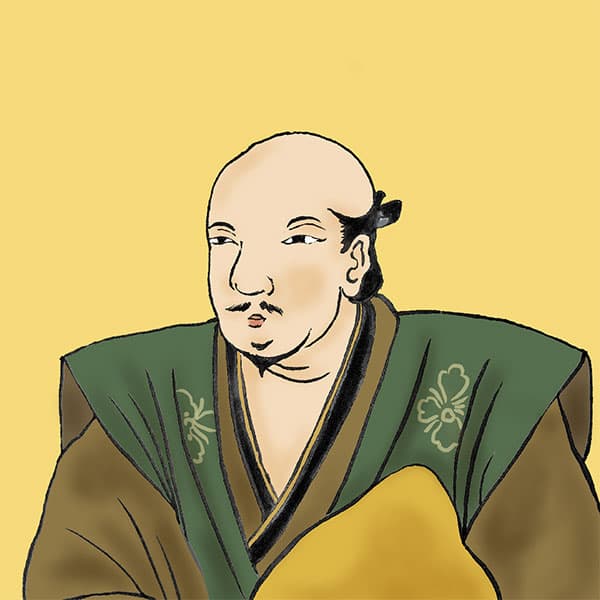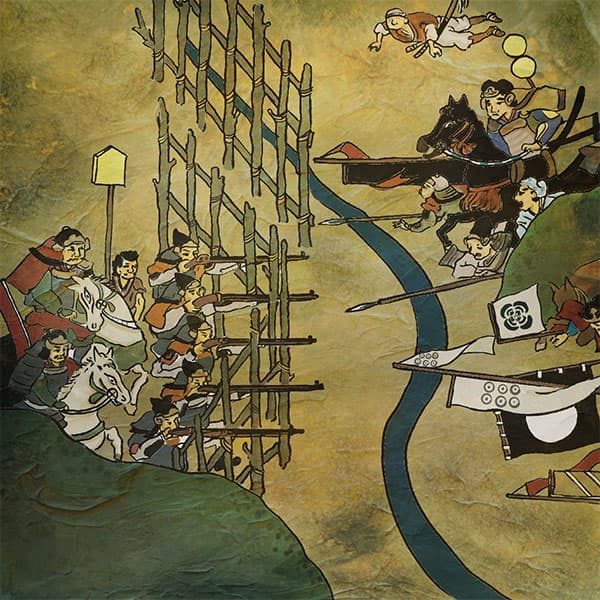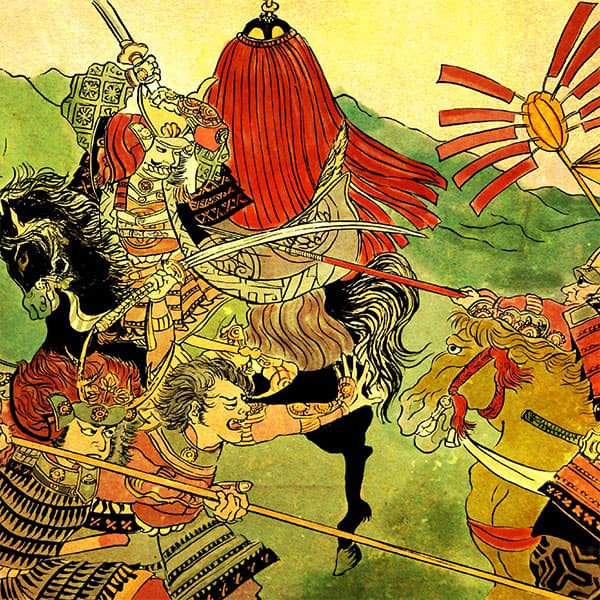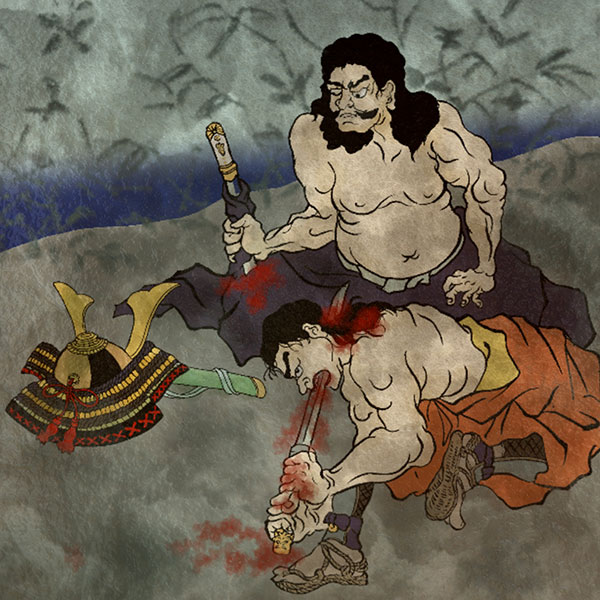Katsuyori Takeda (2/2)An excellent military commander who struggled after his great father.

Katsuyori Takeda
- Article category
- biography
- name
- Katsuyori Takeda (1546-1582)
- place of birth
- Yamanashi Prefecture
- Related castles

Kofu Castle

Tsuchigasakikan
- related incident
In March of the same year, the Takeda family's Takatenjin Castle fell into a predicament due to an attack by the Tokugawa army (the Battle of Takatenjin Castle). Around this time, Katsuyori, who was trying to make peace with Nobunaga, was wary of irritating Nobunaga, and was unable to send a supporter, leading to the fall of Takatenjin Castle.
The Takeda family's vassals were greatly upset because they did not go to support them even though their castle was being attacked. In addition, the Oda family took this opportunity to publicize the fall of Takatenjin Castle, and the Oda and Tokugawa forces became more aggressive, and rebels and opportunistic locals began to rebel.
In February 1582, Shingen's son-in-law, Yoshimasa Kiso, who was in charge of defending Kisoguchi, asked Toyama Tomotada, a powerful clan from Mino Province, to mediate and defected to the Oda side. At the same time, Anayama Baisetsu, a clan that protected the Sunzu border, also promised to treat the Tokugawa family.
This internal collapse of the Takeda family led to the Oda family's subjugation of the Takeda family. Nobutada Oda invaded the Takeda territory from Mino Province, Nagachika Kanamori from Hida Province, Ieyasu Tokugawa from Suruga Province, and Ujinao Hojo from Kanto and Izu Province (Koshu Conquest). At the same time, Mt. Asama erupted on February 14th.
Kai-Shinano was attacked by neighboring countries, and the eruption of Mt. Asama was seen as an ominous omen, and the Takeda clan was in a state of turmoil. The only organized resistance was at Takato Castle, where Katsuyori's younger brother Nobumori Nishina was holed up.
Unable to resist, Katsuyori set fire to the newly built Shinpu Castle and fled. However, he was overtaken by the Oda family's pursuers at Mt. Tenmoku, and in the end committed suicide and passed away (Battle of Mt. Tenmoku). He passed away at the age of 37.
His death was ``The dim moon is faintly clouded, and the mountains to the west are clearing up.''
His eldest son, Nobukatsu, and his legal wife, Mrs. Hojo, also committed suicide on Mt. Tenmoku, leading to the end of the Kai-Takeda clan. However, Takeda Shingen's second son, Nobuchika Unno, who was blind, survived and his descendants continued to be known as the Takeda clan during the Edo period.
Tsujigasakikan, Shinpu Castle, and Kofu Castle
Tsutsujigasakikan was the residence of Takeda Nobutora, Harunobu (Shingen), and Katsuyori. Tsutsujigasakikan was built by Katsuyori's grandfather, Nobutora Takeda, in 1519 in Yamanashi District, Kai Province (currently Kofu City, Yamanashi Prefecture). Since then, it has been the residence of the Kai Takeda family for over 60 years.
However, the Takeda family was defeated in the Battle of Nagashino and was at a disadvantage after that, and in March 1581, Nobuaki Anayama (Baisetsu), a member of the Goichi clan, proposed a plan to Katsuyori and built Shinpu Castle. Masu. Shinpu Castle was a very large castle considering that the entire surrounding terrain had military significance, but it was left unfinished due to the collapse of the Takeda family shortly after.
After the fall of the Takeda family, the Oda family became the rulers of Kai, but after Oda Nobunaga was also defeated in the Honnoji Incident, the Tokugawa family took over. Tokugawa Ieyasu initially used Tsutsujigasakikan as his base in Kai, but later began construction of Kofu Castle.
Afterwards, when Kofu Castle was ruled by the Toyotomi family, it was developed as an important base for monitoring Tokugawa Ieyasu, who was transferred to the Kanto region. However, after the Battle of Sekigahara, Kai was once again under the control of the Tokugawa family, with Kofu as its center.
Today, Takeda Shrine was built on the site of Tsutsujigasakikan and still stands today.
The site of Shinpu Castle was designated as a national historic site in 1973 as the ``Shinpu Castle Ruins'' and was turned into public land for preservation. Fujitake Inari Shrine has been erected on the site of the main enclosure.
Kofu Castle was abandoned in the Meiji era and the buildings were removed, leaving only the stone walls. After the war, parts of the castle ruins were maintained as Maizuru Castle Park and Kofu City Historical Park, and are now open to the public.
Places related to Katsuyori Takeda
- Goroyama and Nishina Morinobu Shrine
- There is a shrine dedicated to Nishina Goro Morinobu (Takeda Shingen's fifth son), who fought with Oda Nobutada who came to subjugate the Takeda clan.
In 1582, Oda Nobutada marched from Gifu along the Shinano Route with 50,000 soldiers to subjugate the Takeda clan. While other clans and vassals seceded from the Takeda family, Morinobu Nishina became the lord of Takato Castle on Katsuyori's orders and attacked them with 500 soldiers.
The battle was fierce, but Takato Castle fell and Morinobu was killed. When the Oda soldiers pulled up from Takato, the farmers of the village searched for the bodies of Morinobu and other samurai, brought them back, cremated them, and buried them on this mountain.
Since then, this mountain has come to be called Mt. Goro, and there are shrines and statues dedicated to Morinobu and the Takeda soldiers. - Nagashino Shitaragahara Parking Area
- This is a parking area on the Shin-Tomei Expressway in Shinshiro City, Aichi Prefecture. The area around the PA is where the Battle of Nagashino Shitarahara took place, and from the down PA you can walk to the adjacent Oda Nobunaga headquarters ruins. The building located in the parking area has a distinctive structure with an uphill and a downhill section. The uphill route (towards Tokyo) is inspired by the Takeda army at the Battle of Nagashino Shitarahara, and the downhill route (toward Nagoya) is inspired by the headquarters of the Oda-Tokugawa allied forces.
- Shingen Museum
- Takeda Shrine was built on the site of Tsuchigasakikan, where three generations of the Takeda clan, Nobutora, Shingen, and Katsuyori, lived. Near Takeda Shrine, there is the ``Kofu City Takeda Clan Historical Museum,'' which introduces the history of the Takeda clan and the results of the excavation survey of Tsuchigasakikan.
The area will include an exhibition room with guidance and museum functions, as well as a study room that can be used for history courses and workshops. There is also a VR experience inside the museum, where you can experience Takeda's history.
Reread Katsuyori Takeda's article
- related incident

- WriterTomoyo Hazuki(Writer)I have loved history and geography since my student days, and have enjoyed visiting historical sites, temples and shrines, and researching ancient documents. He is especially strong in medieval Japanese history and European history in world history, and has read a wide range of things, including primary sources and historical entertainment novels. There are so many favorite military commanders and castles that I can't name them, but I especially like Hisashi Matsunaga and Mitsuhide Akechi, and when it comes to castles, I like Hikone Castle and Fushimi Castle. Once you start talking about the lives of warlords and the history of castles, there's a side of you that can't stop talking about them.







